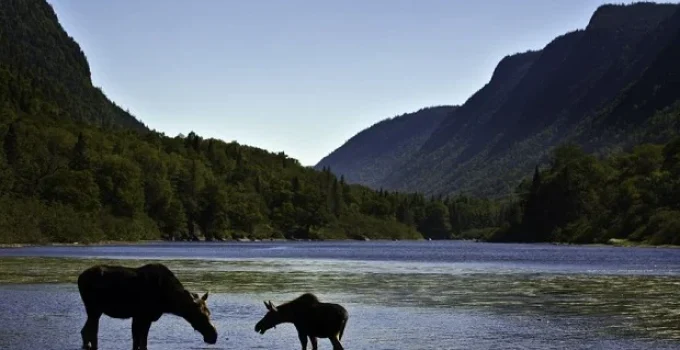Are Moose Nocturnal?
No, moose are not strictly nocturnal—but they are most active during dawn and dusk, making them crepuscular animals.
This activity pattern helps them avoid predators and human disturbances while optimizing their foraging routines. While moose can be active at night, especially in areas with low human traffic or during the rutting season, they are not true nocturnal creatures like owls or bats.
Dive Deeper
- Quick Summary Table
- What Does Nocturnal Mean?
- Are Moose Active at Night?
- When Are Moose Most Active?
- How Light and Season Affect Moose Behavior
- Moose vs. Other Animals
- 🔬 Dive Deeper
- 🎯 Final Thoughts
- 📚 References
🔍 Quick Summary Table
| Behavior Pattern | Description | Comparison |
|---|---|---|
| Nocturnal | No – Moose are not primarily active at night | Unlike owls or raccoons |
| Diurnal | Partially – Moose are sometimes active by day | Less consistent than deer |
| Crepuscular | Yes – Most active at dawn and dusk | Similar to elk and bears |
| Seasonal Variation | Yes – Activity shifts during rut and winter | Common in large ungulates |
🦉 What Does Nocturnal Mean?
Being nocturnal means an animal is primarily active during the night and rests during the day. Moose don’t fall neatly into this category. Instead, they demonstrate a crepuscular rhythm—most active during twilight hours, just after sunrise and just before sunset.
📊 Stat: In a 2016 study by the Swedish University of Agricultural Sciences, over 65% of moose movements occurred during dawn and dusk hours in summer months [1].
🌒 Are Moose Active at Night?
Yes, moose can be active at night, but this doesn’t make them nocturnal. Their nighttime activity is usually:
- Triggered by low human presence
- Influenced by full moon cycles
- Increased during the rutting season (fall)
➤ Fun Fact: Moose vision is highly sensitive to low light, allowing them to navigate efficiently at night or in dense forests—but their eyesight overall is relatively poor compared to their hearing and smell.
📊 Stat: GPS collar data from Alaska showed that moose shifted up to 30% of their activity to nighttime during peak hunting season to avoid human contact [2].
🌅 When Are Moose Most Active?
Moose activity follows a predictable pattern:
- Peak 1: ~1 hour before and after sunrise
- Peak 2: ~1 hour before and after sunset
- Rest Periods: Midday and late night
This pattern helps moose balance:
- Thermal regulation (cooler at dawn/dusk)
- Foraging efficiency
- Predator avoidance
➤ Did you know? Moose spend up to 8 hours per day feeding, often in short bursts spaced throughout the day and night [3].
❄️ How Light and Season Affect Moose Behavior
Moose are seasonally adaptable, changing their activity patterns based on:
- Daylight length
- Temperature
- Predator pressure
- Mating season
Seasonal Trends:
| Season | Activity Pattern | Notes |
|---|---|---|
| Spring | Dawn/dusk active, midday resting | High foraging demand |
| Summer | Crepuscular with some midday hiding | Avoids heat, bugs |
| Fall | Increased all-day and night movement | Rutting season |
| Winter | Reduced activity, energy conserving | Rest more during the day |
📊 Stat: In colder regions, moose reduce daily activity by up to 50% in winter, conserving energy by lying down in snow to ruminate and stay warm [4].
🦌 Moose vs. Other Animals
| Animal | Active Time | Notes |
|---|---|---|
| Moose | Crepuscular | May show nocturnal shifts |
| White-tailed deer | Mostly crepuscular | Similar survival strategy |
| Bears | Diurnal/crepuscular | Highly seasonal |
| Wolves | Nocturnal/crepuscular | Hunt more at night |
| Coyotes | Mostly nocturnal | Avoid human interaction |
🔬 Dive Deeper
Want to explore more about how time of day shapes moose behavior?
- GPS-Based Wildlife Activity Models – Compare how moose in Sweden, Canada, and Alaska adjust activity to daylight.
- Seasonal Stress and Foraging Studies – See how daylight hours, snow cover, and food availability shift energy use.
- Predator-Avoidance Patterns – Explore moose movement in wolf-populated regions and how timing helps survival.
- Human Impact on Circadian Rhythms – Studies on how hunting, traffic, and urbanization affect moose behavior.
🎯 Final Thoughts
Moose are not nocturnal—but they’re not entirely diurnal either. Their crepuscular activity pattern helps them survive, forage, and avoid danger. While they may roam at night under certain conditions, especially in fall or in remote areas, their natural rhythm is driven by light, season, and instinct.
So the next time you spot a moose, remember: it probably knows the timing better than you do.
📚 References
- Eriksson, T., et al. (2016). “Circadian activity rhythms of moose in relation to latitude and season.” Wildlife Biology. https://doi.org/10.2981/wlb.00223
- Alaska Department of Fish and Game. (2021). Moose Activity and Human Disturbance. https://www.adfg.alaska.gov
- Franzmann, A. W. (1981). “Moose feeding behavior and rumination cycles.” Journal of Wildlife Management.
- Van Ballenberghe, V. (2004). “Winter behavior and movement in moose populations.” Alces Journal.
